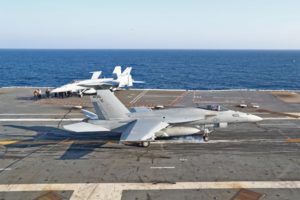The Navy opened a third Service Life Modification (SLM) line to increase Super Hornet flight hours to improve the Navy’s strike fighter inventory levels.
The SLM work involves aircraft maker Boeing [BA] taking F/A-18E/F Super Hornet Block II aircraft nearing the end of their 6,000 flight hour service lives and upgrading them to the new Block III configurations with a focus on pushing their flight hour lifespan to 10,000 hours total.
The process includes two increments, first increasing flight hour lifetime to 7,500 hours then later increasing it to 10,000 flight hours.
In 2019, the company said it initially took 18 months for the first increment of SLM work to upgrade the first Super Hornets in the program but it expected that pace to improve to 12 months as the work line and system improves. The company said it plans to modify up to 40 Super Hornets annually in the SLM program at its peak (Defense Daily, May 7, 2019).
Boeing had previously set up two SLM work lines in company facilities in St. Louis, Mo., and San Antonio, Texas, but the Navy this week disclosed a third one has been started by Rear Adm. Joseph Hornbuckle, commander of Fleet Readiness Centers at Naval Air Systems Command.

“Joe Hornbuckle has started a third SLM line up. Three weeks ago, the first Super Hornet flew out to [Naval Air Station North Island, San Diego] and I was on that airplane two days ago. And it’s going through a modification and a step modification to 7,500 hours,” Rear Adm. Andrew Loiselle, the director of the Air Warfare Division, N98, said during a July 13 event hosted by the U.S. Naval Institute and Center for Strategic and International Studies.
“The outer wing panels are already off. The capacity of Fleet Readiness Center Southwest, the capacity is there, the artisans are there, it’s an MRO facility already and so we’ll start populating the lines.
Loiselle said the Navy had older F/A-18C Hornets that went to depot-level repairs in North Island so now the Super Hornets are “just stepping into those empty bays right now.”
“St. Louis, San Antonio, and a third line is now stood up in North Island. So that’s going to help with strike fighter and inventory management,” he continued.
Loiselle meant increasing the SLM work will help the Navy manage its strike fighter shortfall.
During an April House Armed Service tactical air and land forces subcommittee hearing, members of the panel noted the Navy previously said the strike fighter shortfall would end in 2030, then last year said it would be closed in 2025, but this year has boosted that date back to 2031.
Rep. Donald Norcross (D-N.J.), chairman of the subcommittee, argued the change in shortfall resolution was due to both unplanned reductions in F-35 purchases and lower than expected inductions into the Super Hornet SLM program (Defense Daily, April 29).
At the time, Loiselle said the Navy recalculates the shortfall number every month and is currently conservative on how long it takes to undergo an SLM. He said while Boeing said it currently takes 12 months for an SLM, the Navy allots 15 months.
This week, Loiselle reiterated that point and added as the service calculates the strike fighter shortfall, “it’s literally down to the tail number of each individual aircraft, and how many hours are on that aircraft, and then its projected utilization rates, depending on what we’re going to do with that aircraft, that determines when it’s going to run out of flight hours, and therefore either contribute to the strike fighter shortfall or it will go into” the SLM work.
Loiselle said the Super Hornets getting boosted to 10,000 flight hour lifetime capabilities will provide the Navy with 12 to 13 years of utilization out of each airframe.